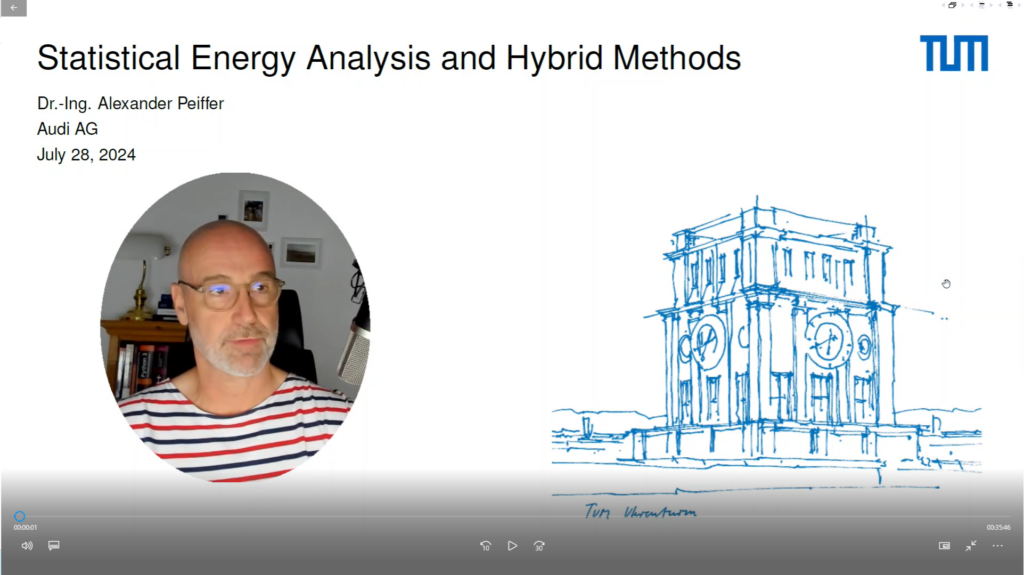Technical University Munich – Summer Semester 2024
This pages presents a series of videos based on my SEA lecture hold during Summer Semester 2024 at TU-Munich
Currently WordPress does not accept embedded YouTube Videos. Please check the channel directly.
Introduction and Motivation
Linear Systems
The linear systems session deals with single to multiple degree of freedom systems of lumped elements (springs, masses and dampers), there response to deterministic and random excitation and how energy is introduced in such systems. In order to deal with random excitation an introduction to random signal theory and spectral analysis is given. The main purpose of this chapter in my book and the lecture is to keep the treatment of SEA self-consistent.
Those who are familiar with linear lumped systems and random signal analysis can skip this main chapter.
Harmonic Oscillator
As this is the simplest case of dynamic resonators some of you might be used to it. However, it is an excellent playground for the presentation of resonances, characteristic dynamic quantities like impedance and dynamic stiffness and power balance. The most important part deals with the various damping processes that lead to the power dissipation ![]() of a system with energy
of a system with energy ![]() using the damping loss factor
using the damping loss factor ![]() .
.
2DOF and MDOF Systems
Short session about the next level – the coupled oscillator and multiple coupled oscillators.
The concept of lumped masses and springs is extended to multiple masses and directions. This is used to explain the global concept of the matrix form of discrete structural systems using mass and stiffness matrices.
Based on this modes and modal frequencies are presented as a resonance of a MDOF system.
Session 3: 2DOF and MDOF systems
Random Process
The session is about the signal analysis of random processes and time histories. This tools set is mandatory to describe excitation and response of systems to random signals and wave fields. Which itself is very important for SEA where the energy is stored in a reverberant and diffuse wave field.
Systems and System Response to Random Excitation
The excitation of dynamic systems with more than one input requires the description of the excitation by cross spectral density spectrum (CSD) of the excitation. For many inputs this becomes a large matrix of CSDs making the calculation unhandy. However, SEA subsystems are represented by reverberant and random wave fields – those fields definitely constitute a random excitation.
Waves in Fluids
The wave equation for acoustic waves is derived. Some solutions are presented in relationship to field quantities. The relationships of power, energy and intensity to the acoustic pressure will later be required to model a cavity by a reverberant sound field and thus as a SEA subsystem.
Fundamental Sources
Fundamental sources are key to the understanding of how power is introduced into a wave field and consequently into cavities.
Therefore, this session deals with spherical sources being representative for fundamental sources. The concept of point sources is derived from the breathing spere, as far as the field and source quantities such radiation impedance and acoustic radiation impedance
Session 7: Waves in Fluids – Fundamental Sources
Reflection and Transmission of Plane Waves
The transmission and reflection of plane fluid waves at an infinite and flat interface provides a first hint how energy is transmitted or absorbed at system interfaces.
The most important quantities are the impedances. This is a first hint for the hybrid formulation of the coupling loss factor.
Session 8: Waves in Fluids – Reflection and Transmission of Plane Waves
The wave equation with sources and boundaries
The solution of the wave equation with sources and boundary equations such as velocity and impedance distributions requires advanced mathematical methods. One option is the Green function and Kirchhoff-Helmholtz integral that follows from the Green function.
A practical application and approximation is the Rayleigh integral that allows the calculation of sound radiation into the semi infinite space.
The session concludes with the decibel scale and related reference values for air.
Session 9: Waves in fluids – In-homogeneous wave equation, solution methods and sound radiation.
Waves in Structures
Basic Definitions of Linear Elasticity, Longitudinal and Shear Waves in infinite isotropic solids
The definition of mechanical stress and stain in linear elastic materials is introduced as far as the related material laws of isotropic material.
The wave equation of wave in infinite elastic material is derived and the two solutions for longitudinal and shear waves as far as the related wave speeds introduced.
Session 10: Waves in Structures – Shear and Longitudinal Waves
Waves in Plates
Waves in Plates and especially bending waves are the most relevant structural wave type in vibroacoustic simulation. This is due to the fact that most technical systems consist of plate like structures (cars, planes, ship and even buildings) and because the displacement normal the plate surface can radiate sound into air.
Session 11: Waves in Structures – Wave in Plates and Dispersion
Fluid Systems
One-dimensional Systems – Fluid Tubes
The most simplistic fluid wave system is the tube. For the tube an analytic solution is derived and the system response to velocity excitation at low and high frequencies can be calculated. It is shown that even though the system is finite it behaves as a semi-infinite system for high frequency excitation.
I conclude with the introduction of modal density, that is an important criteria for ransom systems and dynamic complexity.
Session 12: Fluid Systems – The Tube
